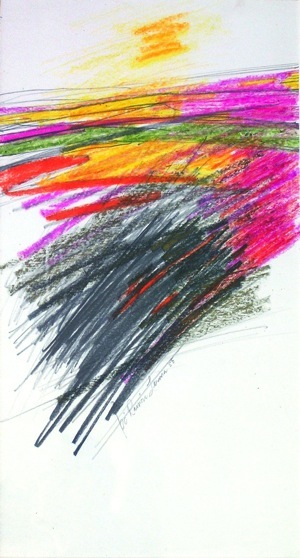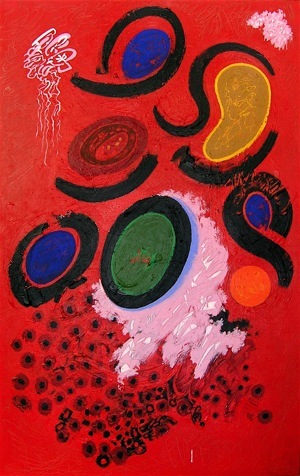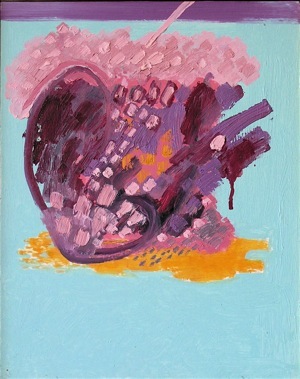Abstract Expressionism, an American post–World War II art movement, is a type of art in which the artist expresses himself purely through the use of form and color. It is non-representational, or non-objective, art, which means that there are no actual objects represented.
Now considered to be the first American artistic movement to achieve worldwide influence, the term was originally used to describe the work of Willem de Kooning and Jackson Pollock.
Technically, an important predecessor is surrealism, with its emphasis on spontaneous, automatic or subconscious creation. The movement's name is derived from the combination of the emotional intensity and self-denial of the German Expressionists with the anti-figurative aesthetic of the European abstract schools such as Futurism, the Bauhaus and Synthetic Cubism. Additionally, it has an image of being rebellious, anarchic, highly idiosyncratic and, some feel, nihilistic.
The movement can be more or less divided into two groups: Action Painting, typified by artists such as Pollock stressed the physical action involved in painting; and Color Field Painting, practiced by Mark Rothko, was primarily concerned with exploring the effects of pure color on a canvas.
The movement is closely associated with painting, collage and sculpture. Although the abstract expressionist school spread quickly throughout the United States, the major centers of this style were New York City, and the San Francisco Bay area of California.
THE BEAT GENERATION IN THE BAY
The connecting theme through art from the Beat Generation is the element of collaboration. Poets, musicians, artists, filmmakers, dancers and thespians all socialized together, which made the San Francisco renaissance all that much more exciting. The Beat Generation was largely made possible by the wave of artist-oriented establishments that began to appear in San Francisco in the early 1950s. To the artists of the Beat Generation, living in the Bay Area allowed them the freedom to experiment, concentrate and make artistic leaps.
Abstract Expressionism swept through the ranks of Bay Area painters in the late 1940s with the intensity of a religious revival. Bay Area painters developed distinctive styles of Abstract Expressionism in the years ahead.
Among teachers at the California School of Fine Arts, David Park, Elmer Bischoff, and Ed Corbett were quickly caught up in the momentum. Abstract Expressionism was no more homogeneous in the Bay Area than it was on the East Coast. Styles ranged widely, even among the students at the California School of Fine Arts, who saw themselves, and were perceived by others, as hard-core Abstract Expressionists: Jorge Goya, Edward Dugmore, Ernest Briggs, John Grillo.
The two artists who became the best-known representatives of Bay Area Expressionism were Richard Diebenkorn and Sam Francis. Other major artists of the movement included Hassel Smith, David Park, James Kelly, Frank Lobdell, and Jack Jefferson.
INFLUENCE
By the 1960s, the movement's initial affect had been assimilated, yet its methods and proponents remained highly influential in art, affecting profoundly the work of many artists who followed. Abstract Expressionism preceded Tachisme, Color Field painting, Lyrical Abstraction, Fluxus, Pop Art, Minimalism, Postminimalism, Neo-expressionism, and the other movements of the sixties and seventies and it influenced all those later movements that evolved. Movements which were direct responses to, and rebellions against abstract expressionism began with Hard-edge painting and Pop artists, notably Andy Warhol, and Roy Lichtenstein. Robert Rauschenberg and Jasper Johns in the US formed a bridge between abstract expressionism and Pop art.
However, many painters, such as Fuller Potter, Jane Frank (a pupil of Hans Hofmann), Elaine Hamilton and José Ramón Lerma continued to work in the abstract expressionist style for many years, extending and expanding its visual and philosophical implications, as many abstract artists continue to do today.
The majority of the content is this article and its links are from wikipedia.
JOSE RAMON LERMA








TEL: 415.441.8680

Contents Copyright © 2003-2009






ABSTRACT EXPRESSIONISM
José Ramón Lerma,
Landscape, 1958, color crayon
and pencil on paper, 13” x 7”
José Ramón Lerma, Sacred Heart,
1976,oil on canvas board,
13 3/4" x 10 3/4"




José Ramón Lerma,
Easy Living, 2004-05,
acrylic on canvas, 48" x 30"



RECENT REVIEWS





